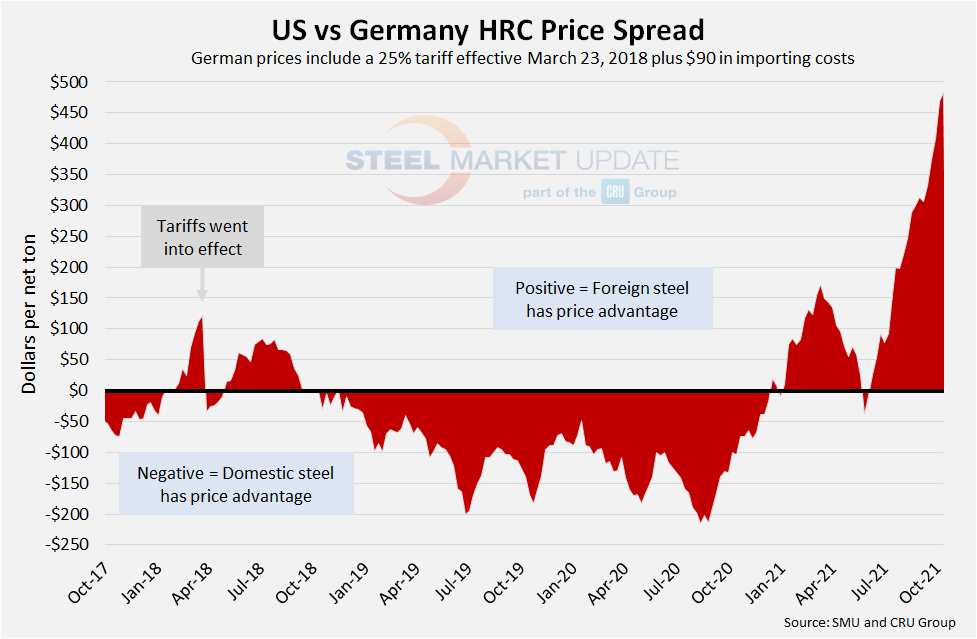Overseas

October 14, 2021
Foreign vs. Domestic HRC Prices: Imports Maintain Big Advantage
Written by Brett Linton
Cheaper foreign hot rolled steel imports continue to tempt U.S. buyers over steel produced domestically, holding potential discounts of 25-43%, according to Steel Market Update’s latest foreign versus domestic hot rolled steel price comparison. Foreign hot rolled steel prices are now theoretically $483-832 per ton cheaper than domestic steel, after taking freight costs, trader margins and tariffs into consideration.
The following calculation is used by Steel Market Update to identify the theoretical spread between foreign hot rolled steel prices (delivered to U.S. ports) and domestic hot rolled coil prices (FOB domestic mills). This is only a “theoretical” calculation as freight costs, trader margins, and other costs can fluctuate, ultimately influencing the true market spread. This compares the SMU U.S. hot rolled weekly index to CRU hot rolled weekly indices for Germany, Italy, and Far East Asian ports.
![]() SMU includes a 25% import tariff effective on foreign prices after March 23, 2018. We then add $90 per ton to the foreign prices in consideration of freight costs, handling, trader margin, etc., to provide an approximate “CIF U.S. ports price” that can be compared against the SMU U.S. hot rolled price. Note that we do not include any antidumping (AD) or countervailing duties (CVD) in this analysis.
SMU includes a 25% import tariff effective on foreign prices after March 23, 2018. We then add $90 per ton to the foreign prices in consideration of freight costs, handling, trader margin, etc., to provide an approximate “CIF U.S. ports price” that can be compared against the SMU U.S. hot rolled price. Note that we do not include any antidumping (AD) or countervailing duties (CVD) in this analysis.
Far East Asian HRC (East and Southeast Ports)
As of Wednesday, Oct. 13, the CRU Far East Asian HRC price decreased $18 per ton to $798 per net ton ($880 per metric ton), up $9 from two weeks prior. Adding tariffs and import costs, the delivered price of Far East Asian HRC to the U.S. is $1,088 per ton. The latest SMU hot rolled price average is $1,920 per ton, down $10 from one week ago, and unchanged from two weeks prior. Therefore, U.S.-produced HRC theoretically is now $832 per ton more expensive than imported Far East Asian HRC, up from $819 last week, but down from $843 two weeks ago. The $847 spread seen in early-September was the largest theoretical spread between Far East Asian and domestic HRC prices in SMU’s four-year history. Prior to 2021, the previous record high was $183 per ton in March 2018.

Italian HRC
CRU published Italian HRC prices at $1,014 per net ton ($1,117 per metric ton), down $31 from last week, and down $43 from two weeks ago. After adding tariffs and import costs, the delivered price of Italian HRC is approximately $1,357 per ton. Accordingly, domestic HRC is theoretically $563 per ton more expensive than imported Italian HRC, up from $534 the week prior, and up from $509 two weeks ago. This is now the largest spread in our limited history (we have seen a new record spread 12 of the previous 13 weeks). Prior to 2021, the previous record high was $143 per ton in July 2016. Recall that in late-May/early-June, Italian HRC briefly lost its price advantage over domestic steel for two weeks.

German HRC
The latest CRU German HRC price is $1,078 per net ton ($1,188 per metric ton), down $20 from last week, and down $60 from two weeks ago. After adding tariffs and import costs, the delivered price of German HRC is approximately $1,437 per ton. Accordingly, domestic HRC is theoretically $483 per ton more expensive than imported German HRC, up from $469 last week, and up from $408 two weeks ago. This is now the largest price spread in our history (we have seen a new record spread 10 of the past 13 weeks). Prior to 2021, the previous record high was $121 per ton in March 2018. Like Italian HRC, German HRC briefly lost its price advantage over domestic steel for two weeks in late-May/early-June.

The graph below compares all four price indices and highlights the effective date of the tariffs. Foreign prices are referred to as “equalized,” meaning they have been adjusted to include tariffs and importing costs for a like-for-like comparison against the U.S. price.

Note: Freight is an important part of the final determination on whether to import foreign steel or buy from a domestic mill supplier. Domestic prices are referenced as FOB the producing mill, while foreign prices are FOB the Port (Houston, NOLA, Savannah, Los Angeles, Camden, etc.). Inland freight, from either a domestic mill or from the port, can dramatically impact the competitiveness of both domestic and foreign steel. When considering lead times, a buyer must take into consideration the momentum of pricing both domestically and in the world markets. In most circumstances (but not all), domestic steel will deliver faster than foreign steel ordered on the same day.
By Brett Linton, Brett@SteelMarkeUpdate.com







